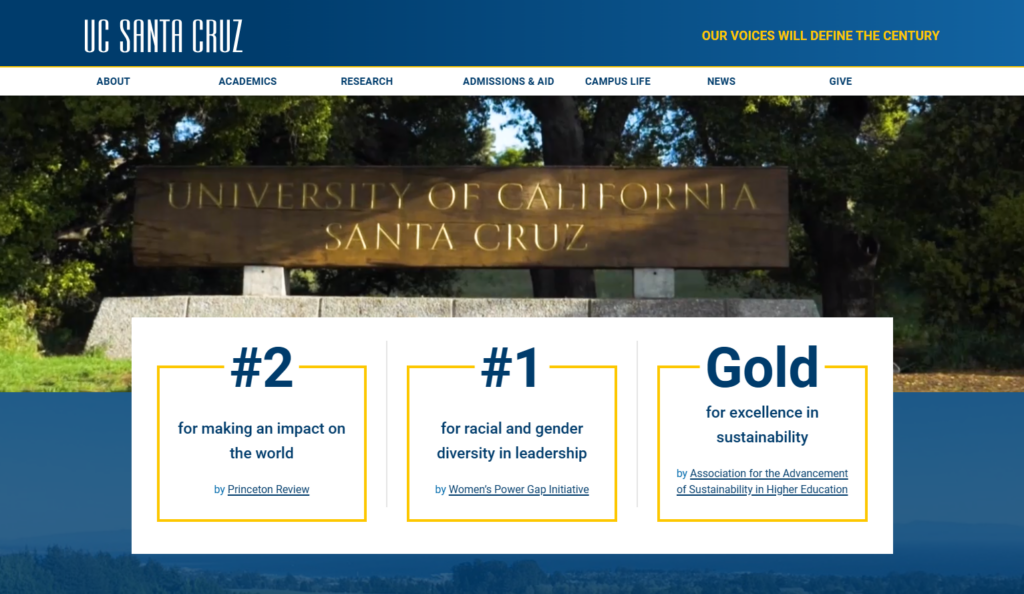Around 18 million students are currently enrolled in college in the US alone. But with enrollment declining slowly since 2010, it’s more important than ever for universities to attract students with the right combination of academics, community, and quality of life.
Your marketing strategy will make or break your enrollment goals.
In this guide, we cover how to create a cohesive strategy—one that will actually help you stand out amongst other colleges—plus, we showcase the 10 best tactics to employ.
How to develop a cohesive marketing strategy for your university
To drive students to your doors, you need to take a step back and think about the core message you’re delivering before you get stuck in the weeds of implementation.
Step 1. Know your differentiators
Start by clarifying your differentiators. Send out a survey to current students and alumni.
Ask them questions like:
- Why did you choose {University Name}?
- Did you tour any other universities? If so, which ones?
- What did you like better about {University Name} than your other options?
- What do you like about living in {City Name}?
Get to the bottom of what makes your college special. Be open to unexpected responses and look for similarities and trends.
Step 2. Create an ideal student profile
Next, create a profile of your ideal student. Of course, you’ll want to attract a mix of different genders, ethnicities, economic backgrounds, and sexual orientations, so don’t focus on demographics. Rather, your ideal student profile is about wants, needs, and priorities. Clarify what your ideal student really cares about in terms of impact, future goals, lifestyle, etc.
Step 3. Develop core messaging
Next, you’ll need to develop core messaging that will attract your ideal students to you.
For instance, UC Santa Cruz has several elements on their website that showcase their core message of positive, wide-reaching impact. The tagline, “Our Voices Will Define the Century” is featured on the homepage alongside rankings and awards for impact, diversity, and sustainability.

Step 4. Create campaigns
Now it’s time to create campaigns. Contrary to popular belief, campaign structure is not about tactics and channels—not yet anyways.
The first step is to think about the message you want to get out into the world.
Maybe, it’s that the most innovative artists come from your college. Or the most successful filmmakers. Or that your college has a measurable impact on climate change.
Clarify the top three to four messages that you want to spread. Each gets becomes its own campaign.
Step 5. Choose your channels and content formats
For each campaign, you’ll then choose the top marketing strategies, channels, and content formats.
For instance, a campaign about diversity might be implemented through social media and influencer marketing, with twenty different posts and ten different influencers. But a campaign about climate impact might get implemented through your digital magazine and content marketing channels.
Below, we showcase the top strategies and channels to consider for your university marketing campaigns.
Top 10 university marketing strategies to try
Choose from these top strategies to fulfill your campaign objectives and target your ideal students.
1. Digital magazines
You can create a digital magazine for current students, alumni, or both. Digital magazines offer an attractive online reading format with single-column content that’s optimized for any device.
Check out these examples of digital magazines for more inspiration.
2. Mobile tour guide apps
Use a platform like STQRY to develop a no-code tour guide app. This way, parents and students who are coming onto your campus can enjoy a self-guided tour at any time. Add important stops and key information about special programs, degrees, communities, offers, clubs, etc.
3. Social media marketing
Social media is an essential channel for universities. Make sure you have a presence on top platforms for young people, like Instagram, TikTok, YouTube, and Snapchat.
Create native content designed specifically for the platform. For instance, on Instagram, you’ll want to combine Reels, feed posts, and Stories.
Make sure to follow universities that target a similar student population so you can stay on top of trends and content formats.
4. Influencer marketing
Influencer marketing is where you use other people’s accounts to publish content, instead of just your own university accounts.
You can hire influencers to create native content for you. A deal might include a few posts published over a set period of time.
Choose influencers based on their age, interests, location, mission, and values. When using influencers for your campaigns, be sure to keep diversity in mind so that you attract a diverse audience and acquire diverse content to re-publish on your own channels.
5. Content marketing
Content marketing contains numerous content formats like blog posts, email newsletters, courses, ebooks, quizzes, and more. All of these content formats can work well for universities, but blog articles, emails, and online courses are especially effective mediums for your campaigns.
Keep in mind that for each campaign objective, there will be dozens of topics to cover. For instance, a campaign on climate impact might include content about your university’s degrees, clubs, staff, alumni, campus sustainability, etc.
6. Alumni marketing
Alumni marketing refers to the practice of sharing alumni stories and successes to attract new students. This strategy can be combined with the other tactics listed here. You might feature alumni on social media as well as your blog content.
7. SEM ads
SEM (search engine marketing) ads are a potent tool for universities to target prospective students actively seeking information online. Utilizing platforms like Google Ads, you can bid on keywords related to your programs, campus life, or other aspects of the university experience.
Craft compelling ad copy that highlights your differentiators and directs users to dedicated landing pages optimized for conversion. With SEM ads, you can precisely target your desired audience based on demographics, interests, and search intent.
8. Organic SEO
Organic SEO (search engine optimization) is crucial for ensuring your university’s rankings in search engine results. By optimizing your website’s content, structure, and metadata, you can improve its ranking for relevant keywords and phrases. Conduct thorough keyword research to identify the terms prospective students are using to find educational institutions like yours, such as location-based or degree-based search terms. Create high-quality, informative content that addresses their needs and interests while naturally incorporating these keywords.
Make sure to optimize your website’s technical aspects, such as site speed, mobile responsiveness, and schema markup, to enhance its search engine performance and user experience.
9. Social media ads
In addition to organic social media content, leveraging paid social media ads can significantly expand your university’s reach and engagement. Platforms like TikTok, Instagram, and YouTube offer effective targeting options to reach your ideal students. You can promote special degrees, open house events, admissions information sessions, student testimonials, academic achievements, or alumni stories.
Track key performance metrics, such as click-through rates and conversion rates, to discover which pieces of content drive the most amount of engagement and traffic.
10. College fairs
Participating in college fairs provides valuable opportunities to connect directly with prospective students and their families face-to-face. Showcase your university’s offerings, answer questions, and forge personal connections that will influence enrollment decisions.
Rely on your campaign strategy and core messaging to help you create engaging booth displays, brochures, and swag that your ideal student will love.
Consider hosting interactive activities or presentations to captivate visitors and differentiate your university from competitors.
Remember—you must be crystal clear on your messaging and how it sets your university apart. Otherwise, you’ll just be contributing to all the noise online.
Make sure to regularly adjust your core messaging and campaign objectives so all your content is created with purpose.
Want to format your digital magazine like a pro publisher? Check out eMagazines.



